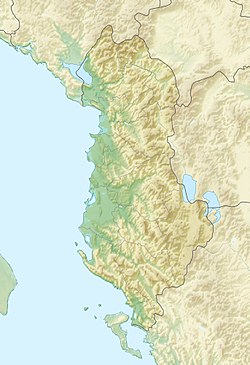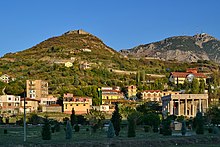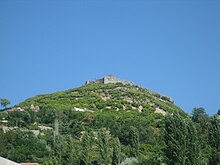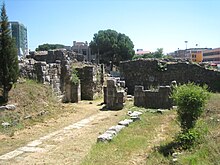Lezhë
Lezhë | |
|---|---|
   Photomontage of Lezhë | |
 Seal | |
 Lezhë | |
| Coordinates: 41°46′55″N 19°38′40″E / 41.78194°N 19.64444°E | |
| Country | Albania |
| Region | Northern Albania |
| County | Lezhë |
| Municipality | Lezhë |
| Founded | 4th century BC |
| Government | |
| • Mayor | Pjerin Ndreu[1] (Socialist Party) |
| Area | |
| • Municipality | 509.1 km2 (196.6 sq mi) |
| Elevation | 10 m (30 ft) |
| Population (2011)[3] | |
| • Municipality | 65,633 |
| • Unit | 15,510 |
| Time zone | UTC+1 (CET) |
| • Summer (DST) | UTC+2 (CEST) |
| Postal code | 4501–4502 |
| Area code(s) | +355 (0)215 |
| Vehicle registration | LE |
| Website | lezha.gov.al |
Lezhë or Lezha (Albanian pronunciation: [ˈlɛʒə]; Latin: Lissus) is a city in the Republic of Albania and the capital of the eponymous county and municipality.
One of the main strongholds of the Labeatai,[4] the earliest of the fortification walls of the city are of typical Illyrian construction and are dated to the late 4th century BC.[5] The city was one of the main centres of the Illyrian kingdom.[6] During the conflicts with Macedon it was captured by Philip V becoming the Macedonian outlet to the Adriatic Sea.[7] The town was later recovered by the Illyrians. It was subjected to Rome after the Roman-Illyrian wars and the fall of Gentius' realm.[6]
The city was the site of the League of Lezhë where Skanderbeg united the Albanian lords in the fight against the Ottoman Empire.
The total population is 65,633 (2011 census),[8] in a total area of 514.97 square kilometres (199 square miles).[9] The population of the former municipality at the 2011 census was 15,510.[8]
Etymology[]
The city is mentioned in ancient sources as Lissos (Ancient Greek: Λισσός) and Lissus (Latin: Lissus, Lissum).[10] The ancient name Lissus evolved into its modern form Lezhë (archaic: Lesh[10]) through Albanian sound changes.[11] In Turkish, the town is known as Leş or Eşim and in Italian as Alessio. Lezhë is also known as Alise, Alexiensis, Eschenderari, or Mrtav.[12]
History[]
Early history[]

From the early Mycenaean period (1600-1450 BC) a free exchange pattern is confirmed with the centres of Mycenaean Greece as seen by various swords (C and D type) unearthed in Lezhë.[14] The earliest human constructions have an Illyrian character and appear on the site from the Late Bronze Age and Early Iron Age.[15] The settlement with its fortifications was built on a 413-metre-high mountain, the Mal i Shëlbuemit, from at least the 8th century BC,[16] and was located near the mouth of the Drin river.[17]


In antiquity the area was described as the territory of the Illyrii tribe (the "Illyrians proper"; Ancient Greek: Ἰλλυριοί, Illyrioi; Latin: Illyrii or Illyrii propriae dicti).[18]
Diodorus ("Library", 15.1, c. 1st century BC) mentions that Dionysius of Syracuse founded a "city called Lissos" in the year 385 BC,[19] as part of a strategy by Dionysius to secure Syracusan trade routes along the Adriatic.[20] Diodorus calls it a polis.[21] It has been suggested that the Syracusan colony mentioned by Diodorus was in fact more likely established at Issa near the island of Pharos, not at Lissus (modern Lezhë) which was too distant for the events described by the ancient historian. Meanwhile, Issa is known from other evidence to be a Syracusan foundation.[22][23][24] Pierre Cabanes notes that there is nothing to connect Lissos with Syracuse except Diodorus' account, and even if Diodorus' account is accepted as accurate, it is very likely that this colony had a short life.[22]
The earliest of the fortification walls of the proto-urban settlement are of typical Illyrian construction and are dated to the late 4th century BC.[25] The transition from the Iron Age fortification of Acrolissus (on the 413 m Shëlbuem mountain) to the proper Illyrian city of Lissus was continuous. The city was built on a lower hill (172 m) near the Iron Age fortification.[26] It was surrounded by ramparts that faced the low valley of the Drin river and the sea coast. Its function was to guard the route inland, to ensure defense against possible attacks from the sea, and to furnish a secure anchorage for the Illyrian ships.[27]
By the 3rd century BC, Lissus was one of the main cities of the Illyrian kingdom under the Ardiaean and Labeatan dynasties.[6] In the 228 BC peace treaty with Rome, the Illyrian queen Teuta promised not to sail south of Lissus at the mouth of the Drin river with more than two lembi (Illyrian light ships), even those had to be unarmed.[28] But when Rome was engaged in a war against the Celtic peoples of the Po Valley in northern Italy about the years 225–222 BC, Illyrian commander Demetrius detached the Atintani tribe from their alliance with Rome. Moreover, he sailed south of Lissus and engaged in piracy in violation of the 228 BC peace treaty. In the summer of 221 BC, tensions in Greece increased as Macedonia allied with the Achaean League against the Aetolian League, and the Illyrians attacked in their typical manner. Demetrius and Scerdilaidas sailed with 90 lembi south of Lissus. When they failed an assault on Pylos (western Peloponnese), they separated their fleets and Scerdilaidas returned north with 40 ships, while Demetrius plundered the Cyclades with 50 ships.[29]
In Roman times Lissus was located in a territory inhabited by the Labeatae, however ancient sources never relate it with this tribe. Taking in account archaeological and historical considerations, the city of Lissus should have been founded in a Labeatan context, but perhaps by the time of Teuta's fall in the end of the 3rd century BC, on a Greek model it was organized as a polis turning away from its ethnic context.[30] The dissociation from the ethnic to the polis coincided with Philip V of Macedon's conquest of a number of cities in Illyria.[31] In 211 BC, Philip V captured Acrolissus, the citadel of Lissus, and Lissos surrendered to him,[32] becoming the Macedonian outlet to the Adriatic Sea.[22] The town was later recovered by the Illyrians. It was in Lissus that Perseus of Macedon negotiated an alliance against Rome with the Illyrian king Gentius, and it was from Lissus that Gentius organized his army against the Romans. Lissus maintained a large degree of municipal autonomy under both Macedonian and Illyrian rule, as evidenced by the coins minted there.[33] During the reign of Gentius in the first half of the 2nd century BC, Lissus minted coins for the Illyrian ruler.[34] The city was of some importance in the Roman Civil War, being taken by Marc Antony [35] and then remaining loyal to Caesar. In Roman times, the city was part of the province of Epirus Nova,[36]
Middle ages[]

During the reign of Justinian I (527-565) the local fortress was possibly mentioned as Alistion in the Synecdemus of Hierocles.[37] At early 590s Lissus was captured by Slavic populations.[38] Byzantine control was re-established during the early 9th century.[39]
In Middle Ages Lezha (known in Italian as Alessio) frequently changed masters until the Venetians took possession of it in 1386. It still belonged to them when Skanderbeg died, but In 1478 it fell into the hands of Turks during the siege of Shkodra, except for a short period (1501–1506) when it returned to Venetian domination.[12] Because it was under the Venetian control, it was chosen in 1444 by Gjergj Kastrioti Skanderbeg as a neutral place for the convention of Albanian nobles and lords of the area aiming at organizing their common defence against the Turks.[40]
Lezha was the site of the League of Lezhë where Skanderbeg united the Albanian princes in the fight against the Ottoman Empire.
Skanderbeg was buried in the cathedral of Lezhë which was dedicated to Saint Nicholas and later used as Selimie Mosque.
Contemporary[]
Today Lezhë is a growing city. Its proximity to the port of Shëngjin as well as its location on the national road between the Montenegrin border to the North and Tirana to the South makes it an attractive location for industry and business.
Majority of the people from Lezhë descend from the Zadrima, Mirdita and Malësia/ regions of northwestern Albania. The people from Zadrima and Mirdita are native to Lezhë and the surrounding area. Whilst the Malësor clans from Malësia, such as Kelmendi, Shkreli, Kastrati etc., had settled Lezhë and surrounding areas around 100–300 years ago. In terms of religion, Lezha has a Catholic majority(70-80%) and a Muslim minority(30-20%)
Geography[]
Lezhë is located mostly between latitudes 41° and 46° N and longitudes 19° and 38° E. The municipality of Lezhë is surrounded in the County of Lezhë within the Northern Region of Albania and consists of the adjacent administrative units of Balldren, Blinisht, Dajç, Kallmet, Kolsh, Shëngjin, Shënkoll, Ungrej, Zejmen and Lezhë as its seat.[41][42] The municipality spans between the Plain of Zadrima in the north, the Pukë-Mirditë Highlands in the east, the mouth of the Mat River in the south and the Albanian Adriatic Sea Coast in the west.[43]
Infrastructure[]
There are urban buses throughout the city and international and national buses. Lezhe has a train station not far from the center. The line starts in Durrës and ends in Shkodër. It is functionally but not frequently.
The main highway in Lezhe is E762. The E762 stars in Fushë-Krujë and ends in Shkodër. The Durrës-Kukës Highway intersects with E762 in Milot. Also, the SH32 intersects in to Lezhe coming from Shëngjin.
Culture[]
The association football club is KS Besëlidhja Lezhë. Although primarily concerned with football, KS Besëlidhja also participates in sports such as wrestling and beach volleyball.
From 2004 an excavation started around the ancient Acropolis of Lissos and the Skanderbeg Memorial, which revealed Hellenistic, Roman and Early Byzantine buildings, tombs and other findings.[44]
Notable people[]
- Skanderbeg, the National Hero of Albania
- Anton Kryezezi, Bishop of Lezhë
- Lekë Dukagjini, prince
- Jonima (Gjoni) family noble family
- Gjergj Fishta, Catholic priest and poet
- Ndoc Gjetja, poet
- Henri Ndreka, soccer player, capped with Albania
- Robert Grizha, soccer player
- Erjon Dushku, soccer player
- Renato Malota, soccer player
- Ornel Gega, rugby union player
- Tosol Bardhi, 16th century Albanian Catholic Priest.
See also[]
- List of mayors of Lezhë
- List of cities and towns in Albania
- List of settlements in Illyria
References[]
- ^ "Kryetari i Bashkisë" (in Albanian). Bashkia Lezhë. 8 December 2020. Archived from the original on 26 October 2020. Retrieved 8 December 2020.
- ^ "Bashkia Lezhe". Albanian Association of Municipalities (AAM). Archived from the original on 8 December 2020. Retrieved 8 December 2020.
- ^ Nurja, Ines. "Censusi i popullsisë dhe banesave/ Population and Housing Census–Lezhë (2011)" (PDF) (in Albanian). Tirana: Institute of Statistics (INSTAT). p. 85. Archived from the original (PDF) on 27 March 2020. Retrieved 8 December 2020.
- ^ Waterfield 2014, p. 49.
- ^ Stylianou 1998, p. 194.
- ^ Jump up to: a b c Shehi 2015, p. 34.
- ^ Cabanes 2008, p. 177; Shehi 2015, p. 34
- ^ Jump up to: a b "Population and housing census - Lezhë 2011" (PDF). INSTAT. Retrieved 2019-09-25.
- ^ "Correspondence table LAU – NUTS 2016, EU-28 and EFTA / available Candidate Countries" (XLS). Eurostat. Retrieved 2019-09-25.
- ^ Jump up to: a b Gaffiot 1934, p. 915: "Lissus".
- ^ Katičić 1976, p. 186.
- ^ Jump up to: a b Catholic Encyclopedia, article "Alessio (Lissus, Alexiensis)"
- ^ Shpuza 2014, p. 118; Shehi 2015, p. 34
- ^ Bejko, Lorenc (2002). "Mycenaean Presence and Influence in Albania". Greek Influence Along the East Adriatic Coast. Kniževni Krug: 12. ISBN 9789531631549. Retrieved 4 April 2020.
The variety of C and D type swords reported from central and northern Albania (Mat river valley, Lezhë, Shkodër), and their provenience from burial contexts, confirm the free exchange pattern with the Mycenaean centers of this part of the country, as in the early Mycenaean period.
- ^ Shpuza 2014, pp. 106, 116, 118: "All the sites described above are situated in the Lowlands of Shkodra, in small hills, which create a protection system of all the area. A similar fortification can be found also at Akrolissos, [...] The chronological framework for the dating of such fortifications is the Final Bronze Age and the Early Iron Age."
- ^ Elsie 2010, p. 272.
- ^ Wilkes 1992, p. 135; Cabanes 2008, p. 177
- ^ Matijašić 2011, p. 299; Boardman & Sollberger 1982, pp. 628–629
- ^ Wilkes & Fischer-Hansen 2004, p. 325: "In 385 Dionysios of Syracuse assisted the Parians to establish a settlement on Pharos, having already sent a colony to the Adriatic and founded “a city called Lissos” (no. 82) (Diod. 15.13.4)." p.332: "Lissos was founded shortly before 385 by Dionysios I [...] on the steep slope of a hill, modern Lezha [...] a site already occupied by Illyrian settlers."
- ^ Evans, A., Destani, B., Ancient Illyria, an archeological exploration. IB Tauris, 2007. p. 276.
- ^ Wilkes & Fischer-Hansen 2004, p. 332.
- ^ Jump up to: a b c Cabanes 2008, p. 177.
- ^ Wilkes 1992, p. 115: "It has been proposed that it was this place [Issa] and not Lissus far to the south at the mouth of the Drin from which help came to the Greeks on Pharos, since Issa lies only 25 miles away."
- ^ Wilkes & Fischer-Hansen 2004, p. 325: "The place from which Dionysios’ fleet came could be the later Illyrian fortress of Lissos (Lezhe) at the mouth of the river Drin in northern Albania, which has an impressive circuit of late Hellenistic masonry fortifications, but is more likely to be in fact the other Greek colony in the area, Issa (Vis) on the island of the same name and known from other evidence to be a Syracusan foundation."
- ^ Wilkes 1992, p. 135; Cabanes 2008, p. 177; Stylianou 1998, p. 194; Shehi 2015, p. 34
- ^ Shpuza 2014, p. 118; Shehi 2015, p. 34
- ^ Wilkes 1992, p. 135; Cabanes 2008, p. 177
- ^ Wilkes 1992, p. 161–162; Errington 1989, pp. 89–90
- ^ Wilkes 1992, p. 162–163; Errington 1989, pp. 91–92
- ^ Papadopoulos 2016, p. 382.
- ^ Shpuza 2017, p. 43.
- ^ Polybius 8.13-14
- ^ Arthur Evans (2007). Ancient Illyria: An Archaeological Exploration. I.B.Tauris. p. 276. ISBN 9781845111670.
- ^ Shpuza 2014, p. 122.
- ^ Plutarch (1920). Life of Antony. Loeb Classical Edition. p. 7.4.
- ^ Epirus Vetus: The Archaeology of a Late Antique Province (Duckworth Archaeology) by William Bowden, 2003, ISBN 0-7156-3116-0,2003, page 233, of Lissus in Epirus Nova
- ^ Winnifrith, Tom (2002). Badlands, Borderlands: A History of Northern Epirus/Southern Albania. Duckworth. p. 75. ISBN 978-0-7156-3201-7.
Also for Justinian's reign there survives a catalogue of towns in the Empire, the Synecdemus of Hierocles." "In Epirus Nova we find Apollonia, Byllis, Amantia, Pulcheropolis (Berat), Aulon (Vlore), Lychnidus (Ohrid) and the unknown Alistion, possible the modern Lezhe, and Skepton
- ^ Pohl, Walter (2018). The Avars: A Steppe Empire in Central Europe, 567–822. Cornell University Press. p. 149. ISBN 978-1-5017-2940-9.
- ^ Curta, Florin (2019). Eastern Europe in the Middle Ages (500-1300) (2 vols). BRILL. p. 308. ISBN 978-90-04-39519-0.
The fortress in Lezhe farther to the north along the coast of the Adriatic Sea, was reoccupied in the early 9th century
- ^ Schmitt Jens O.(2009) Skanderbeg, Der neue Alexander auf dem Balkan, Verlag Friedrich Pustet, pp. 55,56
- ^ "A new Urban–Rural Classification of Albanian Population" (PDF). Instituti i Statistikës (INSTAT). May 2014. p. 15. Archived from the original (PDF) on 14 November 2019. Retrieved 9 December 2020.
- ^ "Law nr. 115/2014" (PDF) (in Albanian). Fletorja Zyrtare e Republikës së Shqipërisë. p. 97. Archived from the original (PDF) on 24 September 2015. Retrieved 9 December 2020.
- ^ "Strategjia Territoriale Bashkia Lezhë" (PDF) (in Albanian). Bashkia Lezhë. p. 10. Archived from the original (PDF) on 8 December 2020. Retrieved 8 December 2020.
- ^ Karl-Franzens Universitat, Lissus excavation report 2004. Archived 2011-06-29 at the Wayback Machine
Bibliography[]
- Beekes, Robert S. P. (2009). Beek, Lucien van (ed.). Etymological Dictionary of Greek. Brill. ISBN 978-90-04-32186-1.
- Boardman, John; Sollberger, E. (1982). J. Boardman; I. E. S. Edwards; N. G. L. Hammond; E. Sollberger (eds.). The Cambridge Ancient History: The Prehistory of the Balkans; and the Middle East and the Aegean world, tenth to eighth centuries B.C. III (part 1) (2 ed.). Cambridge University Press. ISBN 0521224969.
- Errington, R. M. (1989). "Rome and Greece to 250 B.C.". In A. E. Astin; F. W. Walbank; M. W. Frederiksen; R. M. Ogilvie (eds.). The Cambridge Ancient History: Rome and the Mediterranean to 133 B.C. VIII (2 ed.). Cambridge University Press. pp. 81–106. ISBN 0-521-23448-4.
- Eckstein, Arthur M. (2008). Rome Enters the Greek East: From Anarchy to Hierarchy in the Hellenistic Mediterranean, 230-170 B.C. Malden, MA.; Oxford: Blackwell Publishing.
- Elsie, Robert (2010). Historical Dictionary of Albania (PDF). Historical Dictionaries of Europe. 75 (2 ed.). Scarecrow Press. p. 255. ISBN 978-0810861886. Archived from the original (PDF) on 6 October 2014.
- Gaffiot, Félix (1934). Dictionnaire Illustré Latin-Français. Hachette.
- Hammond, Nicholas Geoffrey Lemprière (1966). "The Kingdoms in Illyria circa 400-167 B.C.". The Annual of the British School at Athens. British School at Athens. 61: 239–253. doi:10.1017/S0068245400019043. JSTOR 30103175.
- Katičić, Radoslav (1976). Ancient Languages of the Balkans. Mouton. ISBN 978-9027933058.
- Matijašić, Ivan (2011). ""Shrieking like Illyrians": Historical geography and the Greek perspective of the Illyrian world in the 5th century BC". Arheološki Vestnik. 62: 289–316.
- Papadopoulos, John (2016). "Komai, Colonies and Cities in Epirus and Southern Albania: The Failure of the Polis and the Rise of Urbanism on the Fringes of the Greek World". In Molloy, Barry P.C. (ed.). Of Odysseys and Oddities: Scales and Modes of Interaction Between Prehistoric Aegean Societies and their Neighbours. Oxbow Books. pp. 435–460. ISBN 978-1-78570-232-7.
- Shehi, Eduard (2015). Terra sigillata en Illyrie méridionale et en Chaonie: importations et productions locales (IIe S. AV. J.-C. -IIe S. AP. J.-C.). Col·lecció Instrumenta (in French). 48. Barcelona: Universitat de Barcelona, Publicacions i Edicions. ISBN 978-84-475-4238-3.
- Shpuza, Saimir (2014). Dyczek, Piotr (ed.). "Iron Age Fortifications and the Origin of the City in the Territory of Scodra". Novensia. Warszawa: Ośrodek Badań nad Antykiem Europy Południowo-Wschodniej. 25: 105–126. ISBN 978-83-934239-96. ISSN 0860-5777.
- Shpuza, Saimir; Dyczek, Piotr (2015). "Scodra, de la capitale du Royaume Illyrien à la capitale de la province romaine". In Jean-Luc Lamboley; Luan Përzhita; Altin Skenderaj (eds.). L'Illyrie Méridionale et l'Épire dans l'Antiquité – VI (in French). 1. Paris: Diffusion De Boccard. pp. 269–278. ISBN 978-9928-4517-1-2.
- Shpuza, Saimir (2017). Dyczek, Piotr (ed.). "Scodra and the Labeates. Cities, rural fortifications and territorial defense in the Hellenistic period". Novensia. Warszawa: Ośrodek Badań nad Antykiem Europy Południowo-Wschodniej. 28: 41–64. ISBN 978-83-946222-5-1. ISSN 0860-5777.
- Stylianou, P. J. (1998). A Historical Commentary on Diodorus Siculus, book 15. Clarendon Press. ISBN 0-19-815239-6.
- Cabanes, Pierre (2008). "Greek Colonisation in the Adriatic". In Tsetskhladze, Gocha R. (ed.). Greek Colonisation: An Account of Greek Colonies and Other Settlements Overseas. 2. Brill. pp. 155–186. ISBN 9789047442448.
- Waterfield, Robin (2014). Taken at the Flood: The Roman Conquest of Greece. OUP Oxford. ISBN 978-0-19-166414-4.
- Wilkes, John J. (1992). The Illyrians. Oxford, United Kingdom: Blackwell Publishing. ISBN 0-631-19807-5.
- Wilkes, J. J.; Fischer-Hansen, Tobias (2004). "The Adriatic". In Mogens Herman Hansen; Thomas Heine Nielsen (eds.). An Inventory of Archaic and Classical Poleis. Oxford University Press. pp. 321–337. ISBN 0-19-814099-1.
External links[]
- lezha.gov.al – Official Website (in Albanian)
- Lezhë
- Municipalities in Lezhë County
- Illyrian Albania
- Cities in ancient Illyria
- Archaeology of Illyria
- Ancient Greek archaeological sites in Albania
- Hellenistic Albania
- Gegëri
- Administrative units of Lezhë
- Towns in Albania




